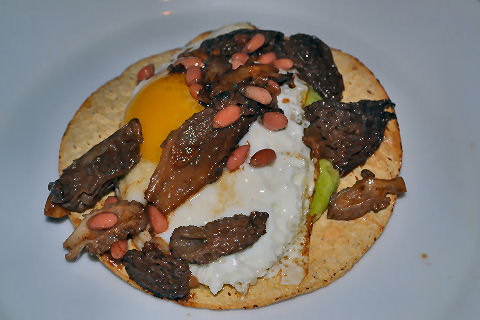
Finally, I got around to making something with the ingredients I bought at the market. Crispy tortillas topped with a fresh fava bean puree, fried egg, and sauteed morel mushrooms and pinenuts with garlic and just a hint of ancho chili. Breakfast of champions?

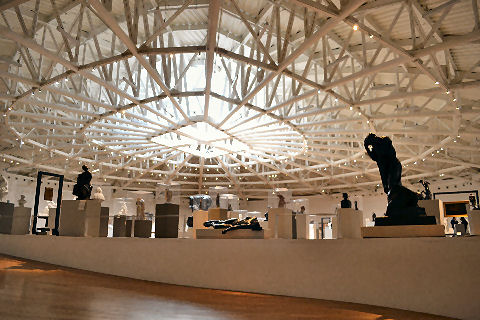
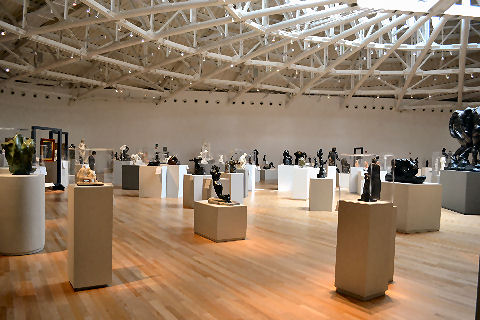

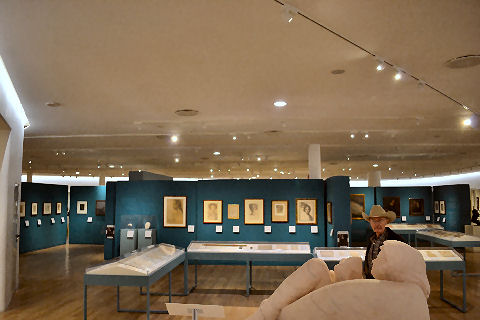
Even larger shots of the Museo Soumaya don’t do it justice, and the word impressive doesn’t either. Awe inspiring? Jaw dropping? Really, really cool? Had to get in a little culture, you know? Private collection of the world’s wealthiest human being, Carlos Slim, along with some visiting exhibitions. An entire floor of sculptures by Dali and Rodin. Admittedly, a couple of floors or predominately religious art, which isn’t my thing, but the other stuff was, yeah, really, really cool.
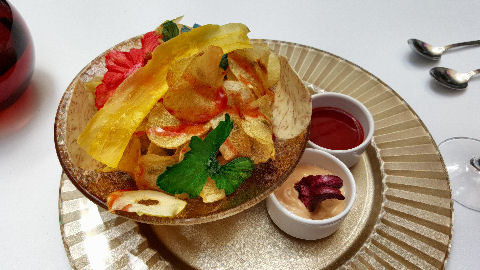
I wasn’t planning on dining at Dulce Patria, Anatole France 100 – it was one of the top 50, but it wasn’t one of the ones I’d narrowed down as “must eat at” spots, coming in at #49. But after museum-ing, I was doing a little shopping through the posh district here in Polanco, and there it was, and they had a table available for lunch, so, what the heck? Even knowing I had a major tasting menu coming up a dinnertime. I’m glad I did too, because I enjoyed myself thoroughly – beautiful space, especially the enclosed patio where I sat, friendly, charming, helpful service, and, really good food. [Closed]
Now, I do have to admit, we had a couple of “lost in translation” moments here. You’d think, being the author of that spanish-english food and wine dictionary, I’d have this all down, but I’m constantly finding new words and new definitions for words. So you see, pepitoria for me, is stewed meat with an egg yolk sauce, traditional in Spain. I figured maybe it came with tortillas, the way so many stews here do, as a little entrada. But, pepitoria in Mexico, it turns out, is a potato chip. Here, mixed vegetable chips (potato, sweet potato, carrot, and hibiscus flowers, which were fried and crispy and dusted in chili salt), with both sweet and spicy dipping sauces, just not quite what I expected.
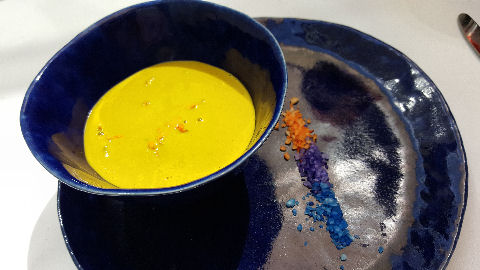
So I ordered a soup before my main course came, just to try something else. I didn’t get the photo snapped before the waiter poured in the soup. Underneath the creamy squash, chili poblano and turmeric soup are toasted almonds and squash blossoms. Needed a hint of salt (and not the colored rock salt on the base plate), which my waiter brought right over. Fantastic soup, really.
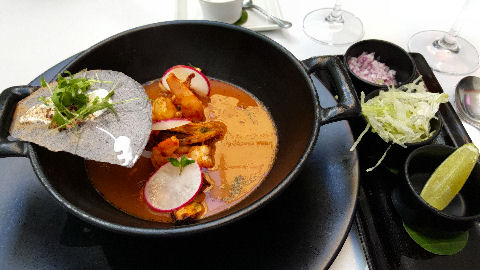
And, another translation moment. Langosta everywhere I’ve been, is a lobster, while prawns are langostinos. But here, it turns out, a prawn is a langosta, and lobster is, well, I’m not sure, perhaps bogavante, which is a type of lobster. I’ll have to ask around or look in the markets on my next visit. Either way, a delicious rendition of pozole – I did expect something more cooked down and stew-like than quite so soupy, but packed full of prawns, mussels, octopuses, and more, along with giant corn kernels and even a little kick.
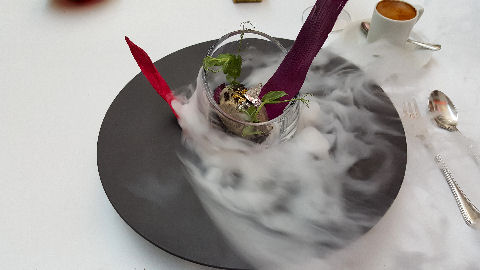
Many of Dulce Patria’s dishes have fanciful names that don’t tell you much about them, particularly the desserts. The La lluvia que apaga el fuego, “the rain that puts out the fire”, was a really intriguing quenelle of burnt corn gelato, coated with edible silver, and served over a cocoa nib “soil”. Dry ice smoke from underneath and some colorful corn husks made for a playful presentation.
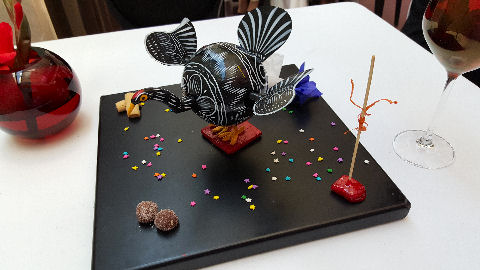
And as if I needed anything else (actually, given that I only ate some of the chips, I’d really not had that big of a lunch, two soups and a scoop of ice cream), a plate of petits fours.
So, Dulce Patria? Beautiful space, great service, really good food that’s presented beautifully, and with lots of colorful touches. Food, glass of wine, espresso, tip – $51. A bargain for the quality.
 On to dinner, at Pujol, Petrarca 254, also here in Polanco. Now, one of the things, and perhaps it’s a conceit, when I make reservations at places like this as I travel, I tend to tell them that I’m a visiting chef and ask if it might be possible to meet their chef, and/or see the kitchen. It often leads to new friendships, and sometimes I get to see some really cool stuff in the works. Didn’t happen at Quintonil, didn’t happen at Amaranta (then again, they didn’t even have my reservation on the books), but Pujol came through. Thumbs up for inviting me back into the kitchen to see it and meet the chef de cuisine, I just wish it had been at the beginning of the meal rather than after… oh my… a cocktail, three glasses of wine, and a shot of mezcal that somehow the sommelier and I put together for me as a pairing sequence. I’m not sure I was entirely coherent nor my usual charming self – it’s kind of a blur, as are later parts of the meal. I’ll do my best… luckily, they give guests a copy of the menu, which is at your place when you sit down in a sealed envelope.
On to dinner, at Pujol, Petrarca 254, also here in Polanco. Now, one of the things, and perhaps it’s a conceit, when I make reservations at places like this as I travel, I tend to tell them that I’m a visiting chef and ask if it might be possible to meet their chef, and/or see the kitchen. It often leads to new friendships, and sometimes I get to see some really cool stuff in the works. Didn’t happen at Quintonil, didn’t happen at Amaranta (then again, they didn’t even have my reservation on the books), but Pujol came through. Thumbs up for inviting me back into the kitchen to see it and meet the chef de cuisine, I just wish it had been at the beginning of the meal rather than after… oh my… a cocktail, three glasses of wine, and a shot of mezcal that somehow the sommelier and I put together for me as a pairing sequence. I’m not sure I was entirely coherent nor my usual charming self – it’s kind of a blur, as are later parts of the meal. I’ll do my best… luckily, they give guests a copy of the menu, which is at your place when you sit down in a sealed envelope.
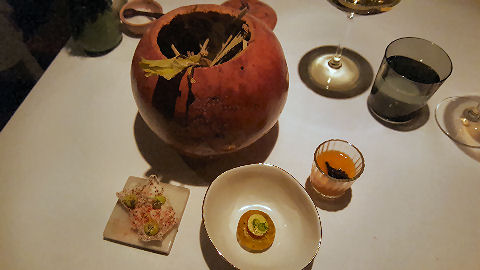
Four out of five botanas – a spicy squash chileatole with a crispy chili chip in it; a little bocol a sort of plump disc of corn masa, to be honest, I don’t remember what it was filled or topped with, but it was delicious; a tostada of chia seeds with a little guacamole, and inside the pumpkin looking thingie, filled with smoking straw, a smoked baby corn cob on a stick, coated in mayo spiked with ground ants, coffee, and chili – my favorite of the bunch. Finished off my cocktail with this – a great blend of sweet vermouth, coffee and burnt cinnamon.
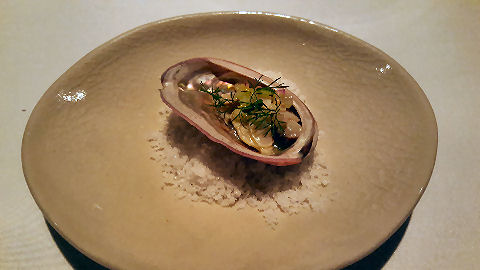
A tasty little clam crudo. Started in on wine #1, a glass of El Cielo’s “Capricornius” Chardonnay, from Valle de Guadalupe – nice barrel aged chard, worked well with this and the next course.
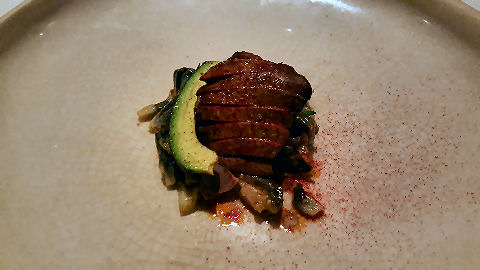
The tasting menu offers options on three of the courses, allowing you to go vegetable (not vegetarian though), pescetarian, or one of two kinds of meat. The sommelier recommended this one highly after I’d picked my next two courses, and he was dead-on – liver and heart of chicken with huitlacoche and avocado – all perfectly cooked and seasoned.
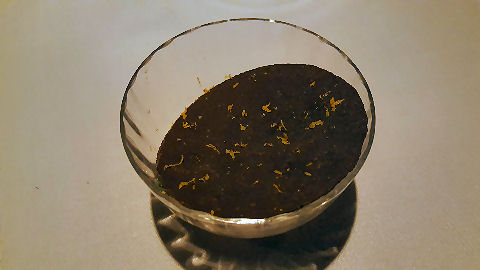
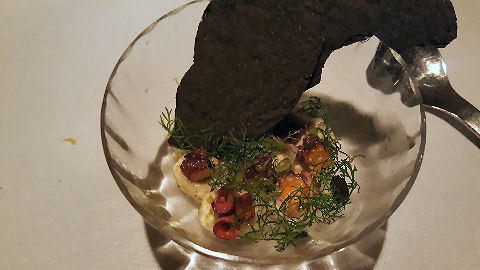
Butter tender bits of octopus with habanero chili and oregano, and a squid ink tostada over the top. Wine #2 came to the fore, Tecate’s Nebbiolo rosé, likewise from Valle de Guadalupe (the main wine producing region, in Baja), another great match.
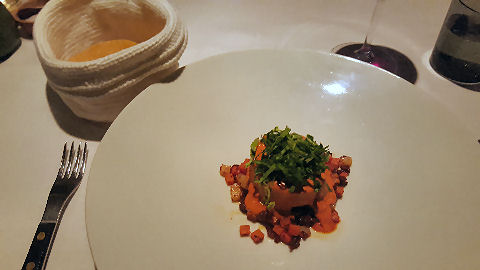
On to the “main” course, a fork tender puck of rabbit in a red guajillo chili and pumpkin seed sauce, tortillas on the side, of course. And, wine #3, Macouzet’s Syrah from Valle de Santo Tomás, likewise in Baja. I’m a little loopy at this point.
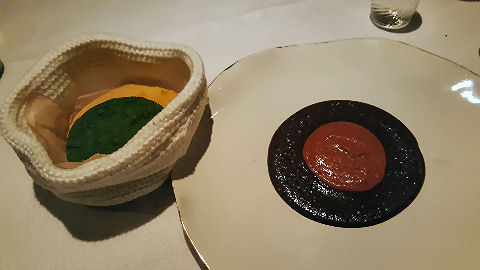
Okay. I have mixed feelings about this course, called “Mole madre, mole nuevo (909 dias)”. Essentially, they have a mole sauce that they’ve been keeping going for now, 2-1/2 years, “feeding it” like one might a sourdough starter. If I understood correctly, they make a new mole sauce each day, use part of it as the mole nuevo, the lighter colored sauce that’s on top, and then at the end of the night, add the remaining sauce to top off the mother one (the darker sauce) and let it keep bubbling away. Served with hoja santa tortillas. And somewhere in here I ended up with a shot of Real Minero’s “Pechuga” Mezcal – which was, as best I can recall, undeniably a perfect pairing, quite possibly the best of the evening.
And it was delicious, and intriguing, and all the good stuff. But it was also sauce on a plate. Can you imagine the reaction in the tradition I was trained in if you put a dollop of “red sauce” that has been simmering away concentrating for years on a plate and topped with a smaller dollop of fresh tomato sauce? And charged $11-12 for it? Even if I put a nice crusty Italian bread on the side? Even as part of a tasting sequence?
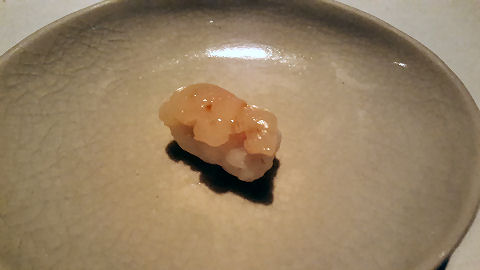
A pre-dessert, all I remember is that it was some sort of sweet sushi, like arroz con leche pressed into sushi form and a fruit topping, perhaps litchi, or something else?
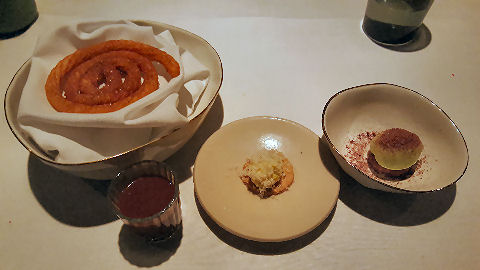
And the Final Feliz, or Happy Ending, of which I vaguely remember the greenish one on the right being something with avocado and cocoa, the middle one being something with white chocolate, and obviously, at the left, a churro with hot chocolate to dip into.
And at this moment, they invited me into the kitchen. There were people working there, I know several people said hola, I know it was gleaming in white and chrome. That’s about what I remember. After that I sorta kinda remember paying and walking back to the apartment, where the owner had left me a space heater after he’d checked in with me earlier in the day and I’d mentioned it was getting a bit chilly here, but I couldn’t figure out how to turn it on – which wasn’t necessarily a function of the alcohol, it took me about ten minutes this morning to figure out how to make it work.
But back to a summation – beautiful room, impeccable service (albeit, apparently, they will ply you with mucho alcohol), and delicious, beautiful food. Expensive, coming in at $193, ($93 for food, $74 for booze). Worth it? Yes. Do it again? With fewer pairings, yes.
Are pepitoria and confusing names for lobster and shrimp just another form of CuisineSpeak, only at a higher level than the “shrimp scampi” and “in its own sauce au jus” that we sneer at?
I don’t think so – I think these are just different definitions in different parts of the Spanish speaking world for the same word. It’s not really surprising, I mean, I can look through the last volume of my dictionary and there are terms that have multiple, wildly disparate definitions, depending on where on the globe you are. I just didn’t think to ask because I recognized the words, I just applied the wrong meaning to them because I didn’t know the alternate one.
I think “shrimp scampi” comes into a similar category, because scampi is both the name of a creature (the Norway lobster, or Langoustine) which isn’t shrimp, and it’s also the name of a style of preparation. It’s not quite the same as simply a regional differentiation in meaning, but a case of a word that actually has two common meanings that aren’t directly related. I didn’t know we were sneering at the use of the dish’s name? When did that come about?
“Sauce au jus” is just someone who doesn’t know what they’re talking about – unless, perhaps, like the double mole dish I described, they’re serving a sauce inside a jus….
The cases of names where people are taking a word and extending knowingly to apply to something that they know it doesn’t actually mean – like my example of carpaccio in yesterday’s post – are another arena to discuss.
[…] from the chef behind the elegant, tranquil, Pujol, where I’d had an alcohol-drenched, but spectacular tasting menu in Mexico City a couple of months back. Cosme, it turns out, is anything but elegant and tranquil, […]
[…] 21st St., Manhattan – So this is the NYC offering from chef Enrique Olivera, the chef behind Pujol, where I had a fantastic meal in Mexico City a few months back. I already mentioned that […]
[…] Mexico City, Mexico: Pujol. […]